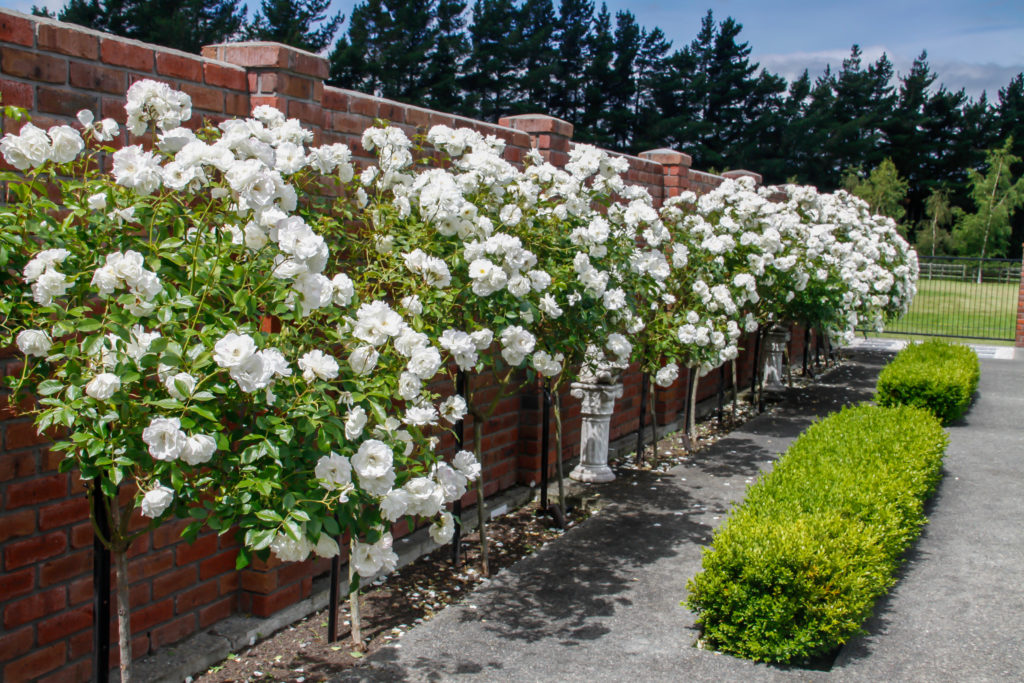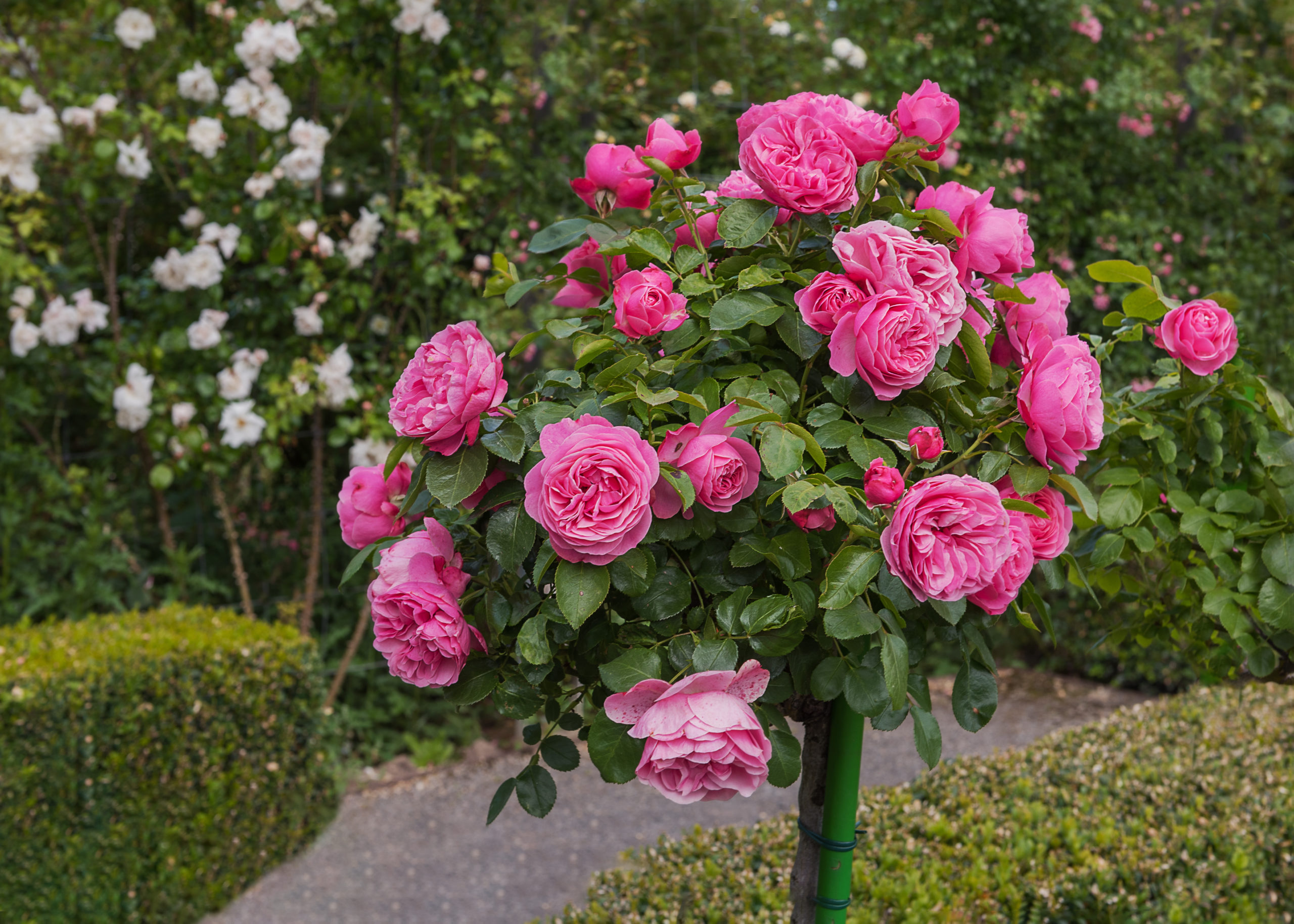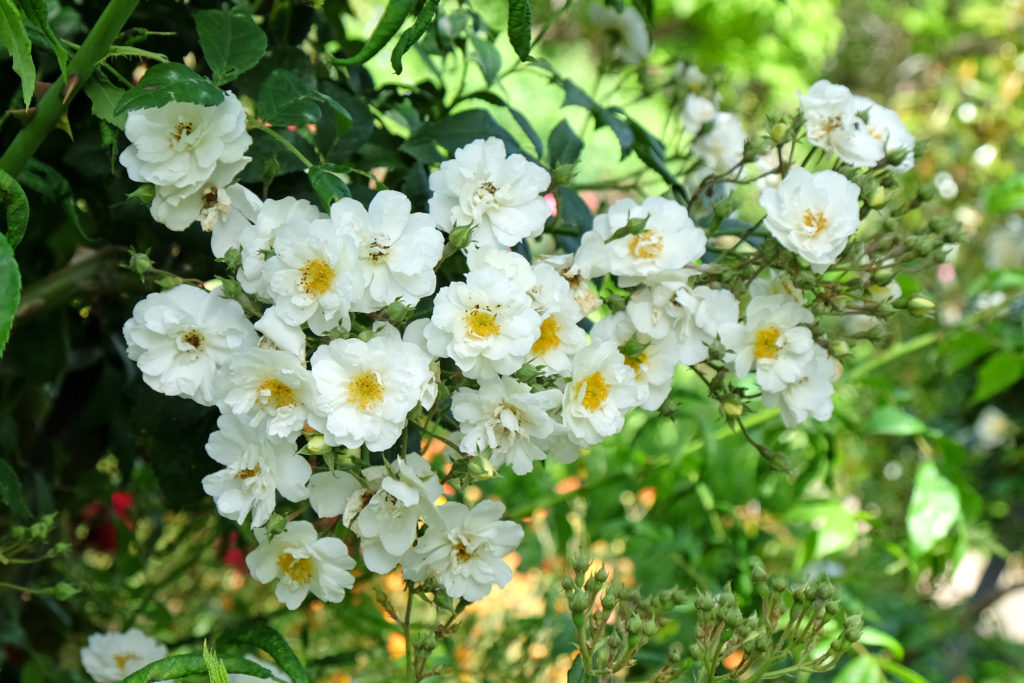Rose trees, also known as standard roses, are an elegant and striking feature in any garden. These roses are created by grafting a bush, floribunda, or hybrid tea rose onto a tall stem, producing a tree-like appearance with a rounded canopy of blooms. This unique form makes them perfect for adding height, structure, and a formal touch to garden designs. Rose trees are often used to line pathways, frame entrances, or serve as focal points in flower beds and containers. With their abundant flowers, strong fragrance, and sophisticated look, they provide a classic and refined aesthetic suitable for both traditional and modern gardens.

Common Types of Rose Trees
There are several types of rose trees, categorised by the variety of rose grafted onto the stem. Some of the most popular choices include:
- Floribunda Rose Trees – These produce clusters of flowers and provide continuous blooms throughout the season. Varieties such as ‘Iceberg’ (white), ‘Rhapsody in Blue’ (purple), and ‘Sexy Rexy’ (soft pink) are excellent choices for those looking for long-lasting colour and abundant flowers.
- Hybrid Tea Rose Trees – Known for their classic, large, single blooms, these trees offer a more traditional and elegant appearance. ‘Peace’ (yellow with pink edges), ‘Blue Moon’ (lavender), and ‘Chandos Beauty’ (creamy apricot) are popular hybrid tea rose trees.
- Weeping Rose Trees – These feature cascading, arching stems that create a graceful, trailing effect. ‘Weeping Pink’ and ‘Weeping White’ are beautiful choices for adding movement and softness to the garden.
- Miniature and Patio Rose Trees – Smaller in scale, these rose trees are perfect for patios, balconies, and containers. Compact varieties such as ‘Sweet Dream’ (apricot) and ‘Little Sunset’ (red-orange) work well in confined spaces.
Caring for Rose Trees
Caring for rose trees is similar to caring for standard rose bushes but with additional attention to their unique form and grafted structure. They should be planted in a sunny position with well-drained, fertile soil. Regular feeding with a balanced rose fertiliser in spring and midsummer encourages continuous flowering and healthy growth. Mulching around the base of the tree helps retain moisture, suppress weeds, and enrich the soil.
Watering is essential, especially during dry periods. The soil should be kept consistently moist but not waterlogged, as overly wet conditions can lead to root rot. When planting in containers, it is important to ensure the pot has adequate drainage and that the rose is watered more frequently than those grown in the ground.
Pruning is crucial to maintain the shape and structure of a rose tree. The best time to prune is in late winter or early spring before new growth appears. Dead, weak, or crossing stems should be removed, and the canopy should be trimmed to maintain a rounded, balanced shape. Unlike shrub roses, rose trees should not be pruned too aggressively, as they rely on maintaining a full, symmetrical form.
One of the biggest concerns for rose trees is protecting the graft union, which is located at the top of the stem where the bushy part of the rose is attached. This area is particularly vulnerable to harsh weather conditions and should be protected from strong winds, frost, and heavy snowfall. In colder regions, wrapping the top of the tree in horticultural fleece during winter can help prevent damage.
Like all roses, rose trees can be susceptible to pests and diseases such as aphids, black spot, and powdery mildew. Regular inspections, good air circulation, and the use of organic or chemical treatments when necessary can help keep the rose healthy. Companion planting with garlic, chives, or marigolds can also help deter pests naturally.
Ways to Use Rose Trees in the Garden
Rose trees are incredibly versatile and can be used in a variety of ways to enhance different garden designs. Their structured form makes them ideal for lining pathways or garden borders, where they create a striking and symmetrical effect. Placing them at regular intervals along a walkway or driveway provides an elegant, classical look, especially when underplanted with low-growing flowers such as lavender, alyssum, or boxwood.
In formal gardens, rose trees work beautifully as focal points, drawing attention with their height and abundant blooms. A single rose tree placed in the centre of a circular flower bed creates a stunning feature, particularly when surrounded by seasonal perennials and compact shrubs. Using a mix of rose tree varieties in different colours can add vibrancy and depth to the design.
For smaller gardens or urban spaces, rose trees make excellent container plants. Positioned on patios, balconies, or entranceways, they bring height and elegance to confined spaces. When grown in pots, it is essential to choose a large, sturdy container with good drainage to support the weight and structure of the tree. Regular feeding and watering will keep potted rose trees blooming throughout the season.
Another creative way to use rose trees is to incorporate them into mixed planting schemes. They pair beautifully with flowering perennials such as salvia, catmint, and verbena, which provide a contrasting texture beneath the rose canopy. Ground cover plants like creeping thyme or heuchera add colour and interest at the base of the tree, creating a layered and dynamic effect.
For a more romantic and whimsical feel, rose trees can be planted in groups of three or five to create a stunning, dramatic display. When combined with climbing roses trained on nearby structures such as arches or pergolas, the result is an enchanting and immersive floral experience.
With their structured form, abundant flowers, and timeless appeal, rose trees are a fantastic choice for gardeners looking to add elegance, height, and a touch of grandeur to their outdoor spaces. Their ability to thrive in a variety of settings makes them a valuable addition to both classic and contemporary garden designs.


